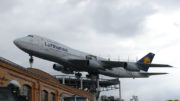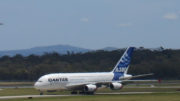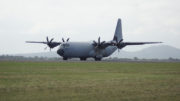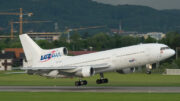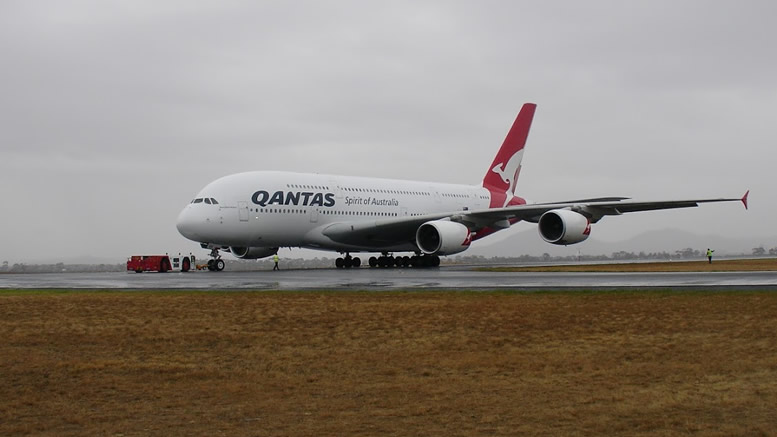 The Airbus A380 – known for many years during its development phase as the Airbus A3XX – will be the largest airliner in the world by a substantial margin when it enters service. Currently under test are the first four test aircraft, one of which was revealed to a large press gathering who saw the A380s new livery.
The Airbus A380 – known for many years during its development phase as the Airbus A3XX – will be the largest airliner in the world by a substantial margin when it enters service. Currently under test are the first four test aircraft, one of which was revealed to a large press gathering who saw the A380s new livery.
The worlds largest passenger aircraft took to the skies recently leaving Blagnac International Airport in Toulouse, France at 10.29 hours local time from runway 32L. The first flight marks the beginning of 2,500 hours of test flights on a total of five development aircraft. The Airbus A380 is expected to enter service during the second half of 2006 with the first operator Singapore Airlines. The thirteen launch customers include Emirates Airlines, Singapore Airlines, Air France, Qantas, Virgin Atlantic, Korean Air and ILFC.
The new Airbus will initially be sold in two versions: the A380-800, with the ability to carry 555 passengers in three-class configuration for 8,000 nautical miles (14,800km), and the A380-800F dedicated freighter to carry 150 tonnes 5,600 miles (10.400km). Power is provided by a choice of Rolls-Royce Trent 900 or Engine Alliance GP7200 engines. Airbus intend to continue their well-established policy of making cockpit layout, procedures and handling characteristics as similar to other Airbus aircraft as possible: this reduces crewing and training costs and increases safety (as crew only have to learn a single set of procedures for many different types). The passenger version will consist of a full double decker configuration.
In the years prior to the decision to begin the project, both Airbus and arch-rival Boeing had spent a great deal of effort on considering the very large airliner market. Although both manufacturers issued varying statements from time to time, the unspoken but clear consensus was that there was probably room for one maker to be profitable in the 600 to 800 seat market segment, but not two. Both were conscious of the graphic illustration of the business risk involved in splitting a niche market provided by the simultaneous debut of the Douglas DC-10 and the Lockheed Tristar: similarly sized tri-jet widebody airliners, either one of which would have profitably filled the gap between the Douglas DC-8 and the Boeing 747 if only the other one had not taken half its market. Having seen first Lockheed and then Douglas run into financial difficulties and be forced out of the air transport industry, Airbus and Boeing were very conscious that the decision to build a 600-seat airliner could not be taken lightly.
Neither manufacturer could afford the enormous capital cost of developing an all-new airliner, especially one of A380 size, unless there was a reasonable expectation of having exclusive access to the market segment and yet neither could afford not to develop a 600-seater if the other did. To do nothing would be to cede market leadership to the competition.
The initial advantage was with Boeing. Boeing’s 747, although designed in the 1960s, had been kept up-to-date and was larger than Airbus’ largest jet, the A340. For many airlines, the extra size of the 747 made that type a “must buy” for their highest density routes, and the cost advantages of fleet commonality were an incentive to buy smaller Boeings as well. There was room to stretch the 747-400 and still retain reasonable seat-mile costs, while the A340, as an already-stretched version of the twin-jet A330, was approaching its upper limit.
After years of design studies and airline surveys, Airbus finally made the decision to go ahead with the $US10.7 billion A380 project in 1999. The design strategy was carefully crafted. Merely by being very large, the A380 could achieve much better seat-mile costs than any other aircraft (just as the 747 had done in 1969). Because the A340 wing was too small to be efficient at the sort of gross weights required for a 600-seater, an all-new design was needed. Given that the cost of starting from scratch was necessary in any case, Airbus chose not to select a wing that would be optimally efficient at around the 600 tonne maximum gross weight of the A380, but to aim it at the 750 tonne class instead. In doing this they sacrificed some fuel efficiency (because the A380 wing is too big for it) but the sheer size of the design coupled with the incremental advances in technology over the years still allows Airbus to claim 15% better economics than a 747 or an A340. The payoff for Airbus is that it will be a relatively easy task to make still bigger versions of the A380 which will reach their optimum cost-efficiency somewhere around the 700 to 800 passenger mark – close to twice the size of a 747-400.
For Boeing, the announcement of the A380 was a major blow: already faced with heavy expenditure to replace the aging mid-sized 767 line, Boeing were then placed in the awkward position of having to replace their flagship 747 as well, or else cede market leadership to Europe. Boeing’s first action was to announce the Sonic Cruiser concept – a 767-sized near-sonic aircraft that would compete on speed instead of size and economics, but a general lack of market interest has seen this project cancelled. Boeing has announced a plan to replace the both the 757 and 767 with a totally new plane called the 7E7 this plane is being engineered to reduce both running and servicing cost, hence the “E” for economical in the model name.
Initial publicity, particularly from the airlines which have ordered it, has stressed the ability of the A380 to provide increased room and comfort, with open space areas to be used as relaxation space, bars, duty free shops, and the like. Historically, the same type of prediction has always been made when a new, larger aircraft is announced – the 747 is an obvious example – but the economics of airline operation are such that the extra space is nearly always used for additional seating. While most airlines took advantage of the extra space to increase lucrative business class seating. The key change that the A380 will brought to many travellers was not extra comfort or lavish in-flight facilities, but more of the same difference that the 747 made – more seats and lower seat-mile costs.
In 2019 Airbus made the announcement that the A380 will end production by 2021 with only 251 aircraft set to be produced in total. At the start of the program Airbus had hoped to build over 700 planes and once quoted a break even point at 270 planes. Despite the plane being popular with passengers a changing market saw many orders for the huge plane to dry up. Emirates were the air line that loved the A380 the most and ordered 123 planes. With their base in Dubai they are positioned to take advantage of the hub and spoke model the A380 was designed for, flying passengers from Australia and Asia to Europe via Dubai. Singapore was the next biggest purchaser of the A380 and the type’s launch customer but they only purchased 24 aircraft and have since returned four of their leased A380’s. Two of these returned aircraft are the oldest of all the A380’s and have now been striped of their expensive parts and due to be scrapped in France. At an age of only 12 years it is was a very short life for these huge aeroplanes.

